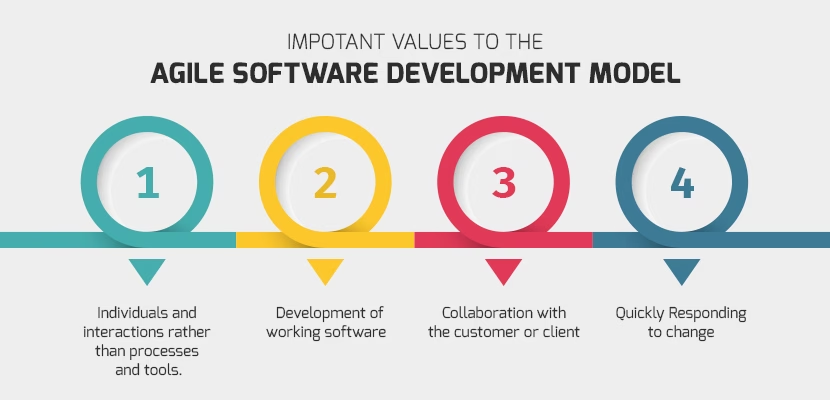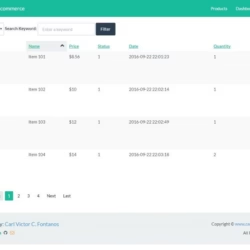- Developers
- Developer Blog
- Project Management Tips
- How to Implement Agile in an Organization?

profile

By Aran Davies
Verified Expert
8 years of experience
Aran Davies is a full-stack software development engineer and tech writer with experience in Web and Mobile technologies. He is a tech nomad and has seen it all.
Wondering how to implement agile in an organization?
This is an important challenge that we will cover here.
Getting your processes right is the key to success. Agile is a project management methodology. However, for the software development community, Agile is now a culture that teams live by.
Few realize that the entire organization, and not just software development teams, can be run according to Agile methodology. A well-oiled Agile organization is ideally suited to thrive in today’s business environment where innovation must be married to fast-paced implementation.
But what exactly is this wonderful methodology and how does it work? In this article, I will take a closer look at Agile and describe how to implement agile in an organization.
What is an Agile organization?
Are you trying to create an Agile organization? If you are, you will need to understand what successful agile implementation involves.
First of all, it is important to realize that the agile journey requires a sustained commitment over a long period of time. It will require changes in perspective, adaptation, and constant revision of business and communication practices.
You will make mistakes, but provided you learn from them to further streamline your approach, you will be successful.
Next, clearly defining/understanding and focusing on your ultimate objective is key, as Daniel Goleman, an expert on emotional intelligence explains in this great article.
Now that you are focused on your goal(s), you are ready to set about building an agile organization.
Characteristics of an Agile Organization
You will have to consider the following characteristics in order to implement agile in your organization:
Goals and approach are clear to everyone
This is the first step. Agile organizations always ensure that goals, core values, and approaches are known by the entire organization. This ensures that everyone is on the same page and working efficiently to achieve the objectives of the organization.
Empowered teams
Since Agile organizational structures are well-defined, this makes accountability very clear. In an Agile organization, no person can say they were not aware of their tasks, and therefore, can be held accountable for their mistakes.

Get a complimentary discovery call and a free ballpark estimate for your project
Trusted by 100x of startups and companies like
Naturally, these incentives individuals and teams to better manage their roles and to ensure that they work together to achieve their goals.
Also, since teams are much more involved in the direction of an organization or project (in software development, teams actually plan upcoming sprints and development timelines), they are empowered to help ensure that realistic goals and deadlines are set.
Quick decision-making and an orientation toward learning
You will often hear claims that Agile claims to guarantee success. This is not true. Agile philosophy actually works from a different mindset. Agile practitioners are taught to learn how to deal with failure.
All forms of business ventures, be they software development projects or transformation projects, etc., are bound to experience failure.
With traditional project management methods, where organizations undertake a project over a long period of time, it is often the case that projects fail to deliver value in the way that was first envisioned. The problem with this approach is that by then significant investments have already been wasted.
Agile operates a “Fail fast, and fail-safe” approach. You can read about it in “Fail fast: fail-safe”.
Agile teaches individuals and teams to learn to fail fast. This ensures that the failure isn‘t costly and therefore, is safe. Since a team is encouraged to learn from failure, they can utilize this lesson to ensure that they deliver successful agile projects in the future.
Rapid decision-making, experimentation, and continuous learning are the name of the game in Agile. The senior leadership in the organization must support teams in regards to how to fail safely and learn from these failures.
Dynamic leadership practices
Agile is not possible without “Servant leadership”. This is a leadership concept that focuses on empowering people in the frontline, i.e. the salesperson, the customer service executive, etc.
The servant-leader is not just end-customer focused but also focuses on his/her team members too. Consequently, the success of the team is also of high importance.
Consequently, servant leaders work towards making the teams‘ work meaningful and productive. Ken Blanchard, the noted management guru explained the concept in an interview. Read it in “Servant leadership is not what you think: Ken Blanchard explains”.
Such leaders create cohesive teams that have an entrepreneurial drive. There is significant flexibility and mobility in such teams, where mobility is driven by merit.
Processes, methods, and tools for the next generation
The purpose of Agile transformation is to deliver greater value to your clients. Indeed, this is one of the key Agile principles. It requires preparing the organization for the future. Using outdated processes, methods, and tools (PM&T) will only deliver conventional results.
All organizations will need to infuse new knowledge, new processes, and new tools into their current business practices. In some cases, they will need to completely replace existing ones that are inefficient.
An example of this can be seen in software development, where new DevOps tools and communication apps such as Slack can greatly increase the efficiency of many in-house communication tools.
Our guide “The 10 best Agile project management tools” can help with selecting the right project management tool. Read it here.
How to implement agile in your organization?

Now that you understand the core ideas behind agile, let’s take a look at how you can implement agile. Recognize that to bring agile to the whole organization, you will need to change your business culture.
Don‘t settle for a mix of Agile and non-Agile: the 1st step
You need to make a crucial decision. Do you want your entire organization to embrace Agile? Or, do you want specific departments/divisions/groups to do so?
My advice is that if you don‘t plan to transform your entire organization into an Agile-driven one, then don‘t undertake this project at all.
There are several reasons I say this. Firstly, as I have already highlighted, one of the founding principles of Agile is to deliver continuous value to the customer. On the other hand, traditional management approaches consider “maximizing shareholder value” as the ultimate objective.
These two approaches directly contradict each other. If senior leaders continue to subscribe to the traditional model, the friction between any department that has embraced Agile and the rest of the organization could cause problems.
Read more about this conflict in “How to make the whole organization Agile”.
Secondly, there is a fundamental difference in the way in which traditional teams and Agile teams work. Managers in traditional teams are expected to know the work/project inside out.
Furthermore, they must constantly issue instructions to their team on the work to be done. This approach is commonly referred to as the top-down approach.
Hire expert developers for your next project
1,200 top developers
us since 2016
Conversely, Agile teams are empowered, i.e., Agile team members make decisions in consultation with their peers. Managers are also part of the decision-making process, but they don‘t make all decisions on behalf of the team.
It is a collaborative effort, one that has at its heart a fundamental shared purpose or goal. If one team is Agile while another isn‘t, the probability of friction is high.
The two above examples do not constitute an exhaustive list of reasons why a partial transformation isn‘t productive, but they are apt examples. My advice is not to take a piece-meal approach.
Put your customers at the top of the priority: The 2nd step
By now, you will understand that customer focus is a fundamental principle of Agile.
It‘s time to put this into practice. We will start by asking some questions:
- Who are your customers?
- Why do they buy your products or services?
- How do they use it?
- What challenges do they face?
- What improved features do they need?
Supposing you know the answers to these already, then it‘s time you ask whether everyone in your organization knows too?
Agile requires everyone in the organization to focus on generating a deliverable and regular value to customers.
How will software developers in your organization know what customers consider valuable about your product if only the sales representative meets your customer, for example? The answer is that they won‘t.
This example exposes the work environment in most traditional organizations. Read “Three ways to make your organization Agile” to see this reality.
There‘s nothing more important to a business than hearing directly from customers. Hence, you need to build cross-functional teams to implement agile in your organization.
The salesperson, developers, designers, and testers should all get feedback regarding the product requirements, for example, directly from customers.
However, the traditional silo culture in traditional organizations doesn‘t allow such information transfer. Therefore, you must change that culture first and ensure everyone in the organization realizes why this is the foundation of success!
Involve the entire organization in the Agile transformation journey: The 3rd step
A transformation on this scale requires ’skin in the game‘ from everyone in the organization. You will need a healthy flow of input from all team members. The planning process needs to involve everyone.
Remember that all employees already carry significant knowledge. They will almost certainly have important insights and valuable information that will help the project. By involving them, you are not only benefiting from their knowledge, but you are also emotionally involving them in the process.
Read more about it in “How to make your organization as fast and agile as a Formula 1 team”.
The 4th step: Bring absolute clarity about the organizational purpose
The most successful organizations have a well-defined purpose. Everyone in the organization knows what that mission is. Managers make sure that teams understand how their work ties into the big picture.
Another good practice is to ensure that everyone knows whether he or she is heading in the right direction. Information regarding their performance or lack of it isn’t hidden away but rather is displayed in front of everyone.
This is an approach that successful Agile organizations share with successful traditional organizations. Remember that this is a practice and not a one-time event. Leaders need to repeat the process for every new task/project.
The celebrated management guru Ken Blanchard explained this process in his book “Gung Ho!”. He outlines three principles: meaningful work, employees in control of achieving the goal, and cross-team support.
The optimal process, not an overwhelming one: The 5th step
Some people have the misconception that Agile doesn‘t need many processes and documentation. The reality is that Agile needs processes, documentation, and discipline. However, it requires only what is needed to ensure the most streamlined agile processes.
Organizational agility requires managers to define and refine optimal processes and documentation, along with their teams. What doesn’t add value to the project is wasteful, and therefore needs to be replaced or eliminated.
A ’Product backlog‘ replaces voluminous requirement documents. ’Sprint planning meetings‘ replace extensive project planning workshops. ’Daily stand-up meetings‘ take the place of the multitude of governance meetings.
To learn more about this process, read “How to build a Scrum development team”.
Iterations instead of a “Big bang”: The 6th step
Agility transformation requires the organization to learn that delivering value is a continuous process. Instead of one big-bang project with lengthy initiation, planning, development, testing, and implementation, you deliver incremental value in iterations.
Customers must be able to see value at the end of the first iteration. In regards to software development, this means a working piece of software with basic functionality. This is called a ’Minimum Viable Product‘ (MVP). From then onwards, each iteration must deliver complete features.
Hire expert developers for your next project
In other words, every iteration in an Agile project must deliver tangible value to the customer. Small cross-functional teams need to work on these iterations. This is a very distinct feature of Agile development.
You as the leader of the organization must ensure teams embrace the Agile approach. You will need the right capabilities to do this. Read “Leading agile transformation: The new capabilities leaders need to build 21st-century organizations” for more details.
Measure what matters to implement agile in an organization: The 7th step
So, now you are underway with your Agile transformation, and your teams have started to work in an Agile way. How are the teams progressing? In order to answer this question, you must measure their progress.
The Agile approach has its‘ own metrics. There are specific ways to track/measure them. A completed feature is “burned down”.
You can track these metrics with iteration status charts called “burn-down charts”. If a team has 10 features to deliver in one iteration, they need to “burn through” these.
If the “burn-down” chart is moving downwards towards the right-hand side, the team is progressing well. If the chart is stagnant, then the team is stuck. If new features are added during an iteration, then that could be a scope creep.
If there is an uptick in the chart, then it signifies a feature previously completed has moved back and required rework. This is not an exhaustive list of Agile metrics or tracking tools, but an example.
Read “Metrics for agile projects” for more information.
The 8th step: Build a “Learning organization” by infusing trust
I have earlier described how “fail fast and fail-safe” is a key characteristic of an Agile organization. Building a learning organization that doesn‘t fear failure takes some effort. Team members should know that they will not be punished for failure.
This level of trust can only come from sustained open communication. An Agile organizational structure should strive to bring down walls that hamper communication.
Whether software developers or network engineering staff, everyone should know that this approach to management is not about apportioning blame.
Failures are opportunities to learn lessons and to set the team on a course of continuous improvement. Read about successful agile transformation and an agile mindset in “Characteristics of Agile organizations”.
If you are looking for developers trained in agile skills, then contact DevTeam.Space. Our operating model is designed to allow product development project teams to quickly onboard and offboard expert developers and dev teams.
Our process is designed to meet all types of customer needs including different organizational cultures, time-to-market pressures, infrastructure or ecosystem issues, emergent changes in market conditions, budgeting considerations, stakeholder pressures, etc.
Our developer community is versed in all new technologies and agile practices. We also provide real-time project progress reports that maximize command and control as well as project adaptability.
Write to us your initial project requirements via this form and one of our account managers will get back to you with further assistance.
Further Reading
Here are a few articles that might also interest you:
Interested in knowing how to create a review website? Below you'll find some useful information about what features a good review website should have and how to make one. In this article What Is a Review Website? Examples of...
Continue reading
Interested in how to create your own trading card game online like Pokémon? While still considered a niche market, Pokémon GO has an impressive 27 million users in the U.S. alone. Its card game trading network is also huge. The market for...
Continue reading
Interested in building a Node.js eCommerce platform? This is a huge market with enormous potential. According to Meticulous Research, "the global e-commerce market is expected to grow at a CAGR of 11.1% to...
Continue readinghttps://www.devteam.space/blog/how-to-create-a-labor-exchange-using-blockchain/
Frequently Asked Questions on how to implement agile in an organization
Adaptable and at the forefront of the latest changes. Can make quick changes as new opportunities arise both in the long and short term.
Increased flexibility in business processes, as well as an increased speed of change, are the top benefits of implementing agile in an organization.
Agile allows organizations to quickly adapt to changing business environments. It is particularly useful in the tech industry where new trends or technologies can literally change everything overnight.

Alexey Semeney
Founder of DevTeam.Space
Hire Alexey and His Team To Build a Great Product
Alexey is the founder of DevTeam.Space. He is award nominee among TOP 26 mentors of FI's 'Global Startup Mentor Awards'.
Alexey is Expert Startup Review Panel member and advices the oldest angel investment group in Silicon Valley on products investment deals.





